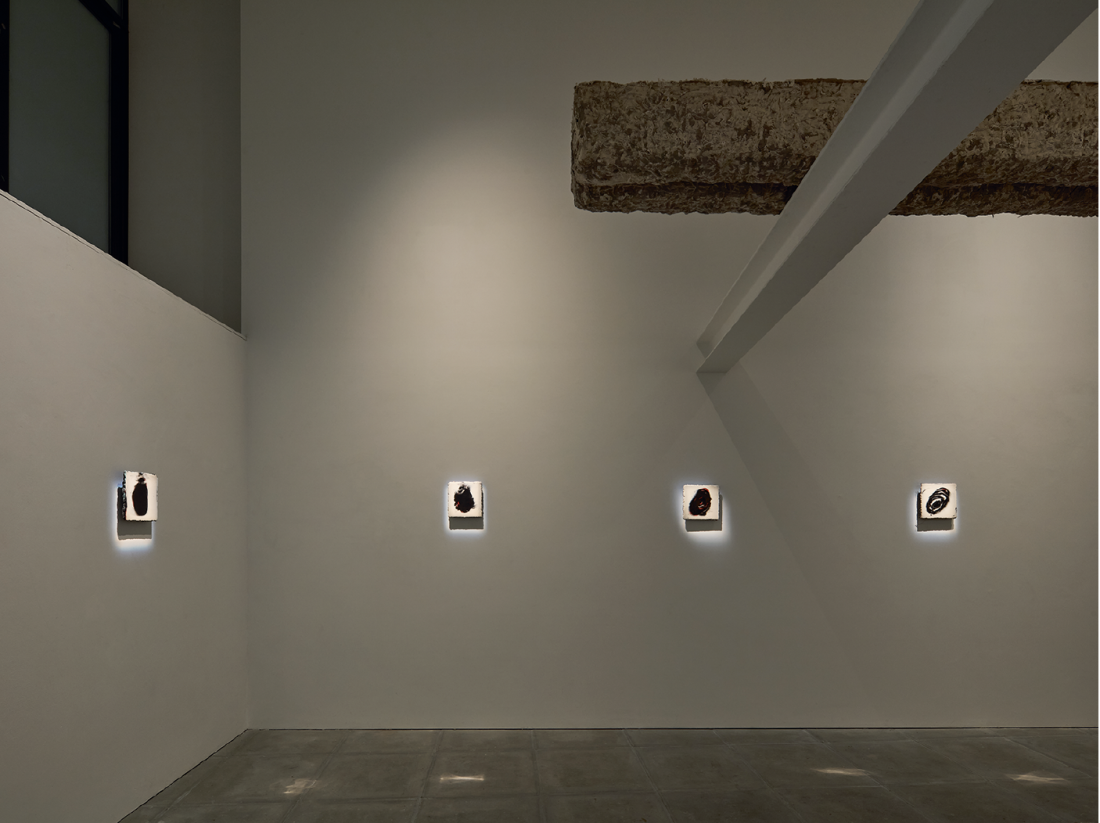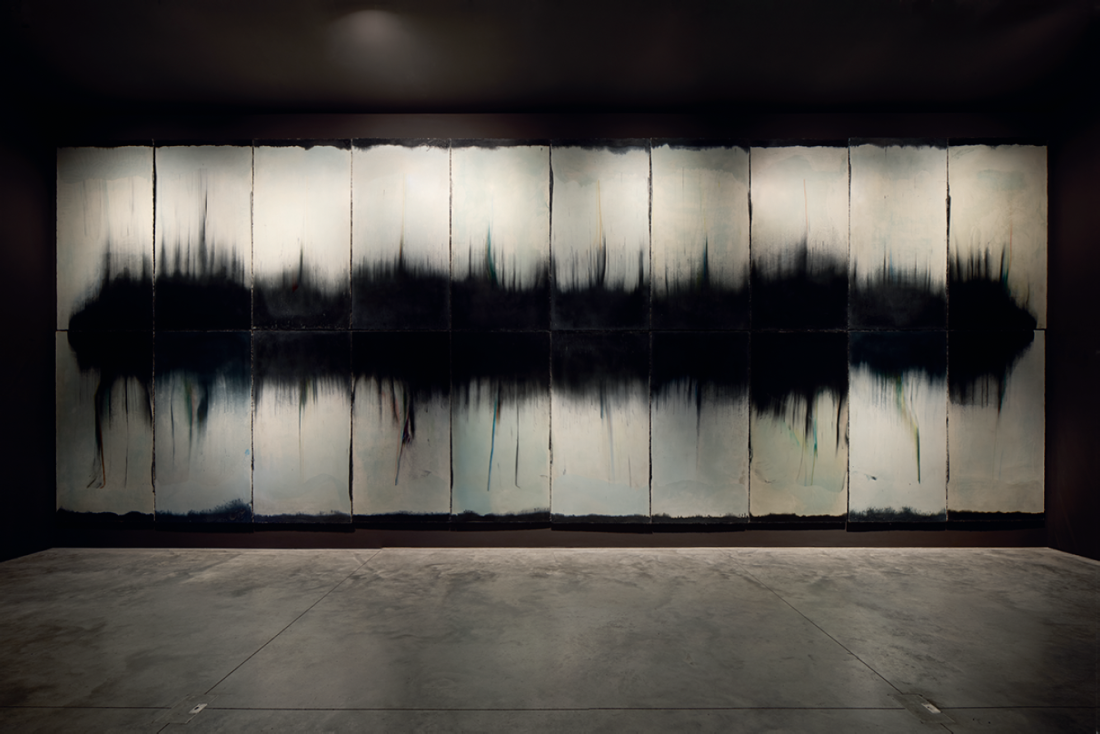Harminder Judge
On the opening night of Harminder Judge’s recent solo show, there was a procession between the two exhibition sites. A contingent of chalk-white figures carried a three-metre-long piece of dense plaster through the streets of south London: a “dead weight … a tree, a body, a ship, a stone …” as Susanna Davies-Crook describes it in her essay accompanying the exhibition.
The funereal crew made its sombre way from Matt’s Gallery, where Judge’s expressionistic multi-panel A ghost dance (folded into), 2024, was installed, to The Sunday Painter, another gallery 10 minutes away. Here the “dead weight” was hoisted through a window and set ablaze in the centre of a room hung with a series of Judge’s 23 x 24-centimetre works: splashes of black, blue or red ossified in lustrous white plaster.
“To be alive, to die and to mark passing is a human performance,” writes Davies-Crook. Specifically, the procession and its fiery conclusion recall UK-born Judge’s background in experimental performance, with an emphasis on body, ritual and spiritual and pop culture. There was his flame- and flesh-inflected Holy Mountain Party at the Brighton Festival, 2012, inspired by Tarot-devoted director Alejandro Jodorowsky’s saturated 1973 cult classic. Or The Modes of Al-Ikseer, 2009–2013, which brought together Hindu storytelling with Depeche Mode’s “Personal Jesus” in an act of milk- and LED-splashed endurance.

Harminder Judge, A ghost dance (folded into), 2024, plaster, polymer, pigment, scrim, oil, 380 × 990 × 4 centimetres (20 parts, each measuring 190 × 99 × 4 centimetres). Photo: Ollie Hammick. Courtesy The Sunday Painter, London.
Judge remembers the frustrations that pushed him to eventually stop making live art. “I just got a bit fed up,” he told Tim Dixon, deputy director of Matt’s Gallery. “I just got a bit tired of trying to fundraise, trying to get museum partners. I missed the studio and being in a material dialogue with the stuff I was making. I was also just a bit poor.” After some fallow time, he returned to the studio. Putting aside the multi-sensory influences of his past, the artist set his sights on a single material—plaster—and he’s been making work with the stuff for the last seven years.
Plaster, Judge reports, sets quickly and doesn’t allow for predictable results. It took several years for him to gain any command over what happened when he poured it into frames, mixing in water, wax, pigment, oil, or whatever else to get colour effects. Mostly, the outcome was anyone’s guess. “I hardly had any control over the material at all,” he says.” I didn’t even know if it was ever going to look good. I just knew that it was my material.”
Judge completed a postgraduate diploma at the Royal Academy Schools in 2021, two years after his first solo exhibition, at Jhaveri Contemporary in Mumbai, where his plaster works took the form of ovals and oblongs and other stone-like shapes. These earlier pieces evoke dynamic landscapes: rich and bright ruptures in the land and sky. The work in the new show is comparatively brooding and stark.
“A Ghost Dance” is a difficult title. It’s taken from a devotional movement that spread among Indigenous tribes on Turtle Island (North America) in the late 1800s. Believers thought that performing the circular ritual would summon ancestors to save them from the scourge of colonial settlers. The dance terrified many of the White western expansionists, and they reacted violently—famously with the massacre of 250 Lakota people at Wounded Knee (South Dakota). While the spectre of colonialism looms large across the globe, the ghost dance has a complex, geographically specific and highly charged history that is, arguably, best suited to Indigenous reappropriations alone.

Harminder Judge, installation view, “A Ghost Dance,” 2024, The Sunday Painter, London. Photo: Ollie Hammick. Courtesy The Sunday Painter, London.
More compelling are the parallels to be made between Judge’s work and prehistoric art—and the main attraction is the large piece at Matt’s Gallery. Covering one of the walls inside a cool, dimly lit room is a monumental assembly of 20 glossy plaster panels spanning nearly 4 metres tall and 10 metres long. The blackish pigment that scrolls along A ghost dance (folded into) looks like a lot of things: a spectrogram, a heartbeat, storm traces reflected in water, a controlled explosion. Knowing what we do about plaster, achieving this compositionally sound pattern across so many large slabs was undoubtedly an act of perseverance—of devotion.
If you’re lucky enough to find yourself in this windowless room alone, you might experience a palpable feeling of first discovery. It’s not an exhibition space; it’s a misty prehistoric enclave with recognizable art markings whose deeper meanings entice and escape you. The air even smells of wet earth.
In her essay Davies-Crook mentions David Lewis-Williams’s The Mind in the Cave, 2002, a gripping examination of Upper Paleolithic rock art including spectacular compositions found on chamber walls that are sometimes kilometres far and deep, away from the sun. Lewis-Williams emphasizes the creative act. He’s interested in what ancient visual culture tells us about consciousness, social status and artists—not art. Like his forebears, whose rock drawings advertise their formal abilities and symbolic discernment, with this ambitious show the 42-year-old Judge has left his mark.
There’s a single relic-object in this shadowy space. It looks like a tree stump or hand drum or rock formation shaped by the sea. Upon inspection, the flat top of A ghost dance (lifted out), 2024, reveals a smiling face roughly sketched into plaster. Maybe it’s a playful self-portrait, a signature left by the artist who’s been working underground but is now ready to be recognized. ❚
“Harminder Judge: A Ghost Dance” was exhibited at Matt’s Gallery, London, and The Sunday Painter, London, from May 24, 2024, to July 14, 2024.
Ananda Pellerin is an award-winning arts and culture writer and editor based between London and Toronto. She works with Penguin Books, Atelier Éditions, Tenderbooks, Taschen, Gestalten, Condé Nast, The Gourmand, CNN, Dazed Media and other outlets.

